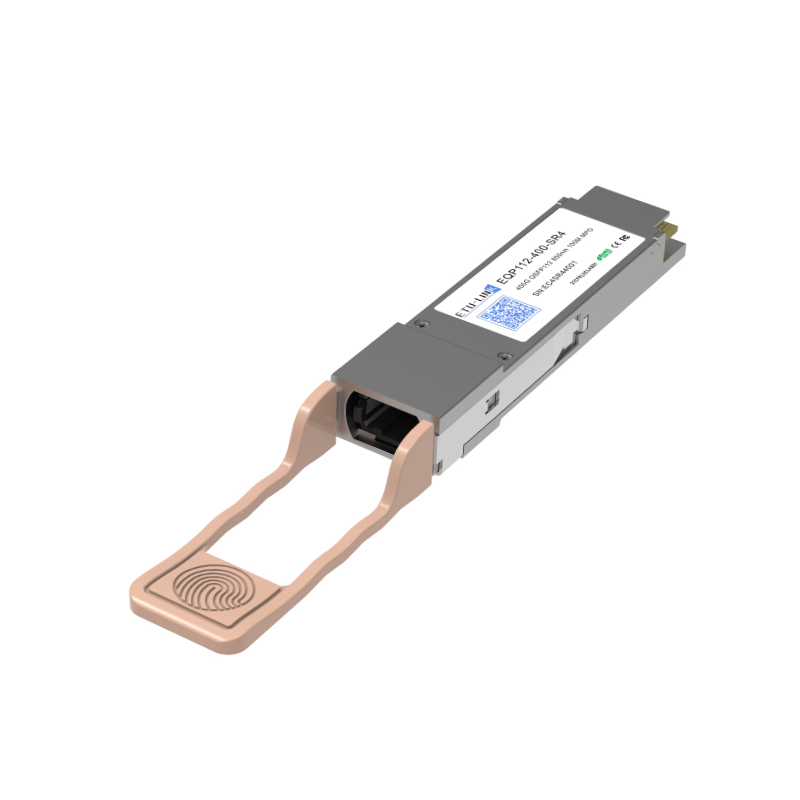
Analysis of 400G Optical Module Packaging Types
Under the background of high-speed development of data centers and telecommunication networks, 400G optical module, as a key component, is gradually becoming the focus of the market. In order to meet different application requirements, 400G optical modules have diversified in packaging technology, and the packaging type is one of the important factors affecting the performance and application of optical modules. ETU-LINK will discuss the main encapsulation types of 400G optical modules and their characteristics through this article.

Basic Overview of 400G Optical Module
Designed to provide transmission rates up to 400Gbps, 400G optical modules are mainly classified into CFP8, QSFP-DD, OSFP, and QSFP112 package types, and are widely used in data centers, cloud computing, and telecom networks. The design not only considers the speed, but also takes into account the transmission distance, power consumption and thermal management and other factors.
CFP8: Laying the Foundation for 400G Optical Modules
CFP8 (Centum Form-factor Pluggable 8) is an extended version of CFP4, the number of channels increased to 8 channels, the size of the corresponding increase. CFP8 package type in the early stages of the 400G optical module has a certain degree of application, but due to its power consumption and volume is relatively large, as well as high cost, so in data centers and other application scenarios are not advantageous. With the development of technology, CFP8 packaging is gradually replaced by more advanced packaging forms.
QSFP-DD: The Package of Choice for Data Centers
QSFP-DD (Quad Small Form-factor Pluggable Double Density) is a dual-density four-channel small pluggable package, a high-speed pluggable module package defined by the QSFP-DD MSA group. As the 400G optical module package of choice, QSFP-DD enables data centers to effectively grow and scale cloud capacity as needed. Its features include:
High Bandwidth: The QSFP-DD package utilizes an 8-channel electrical interface with rates of up to 50Gb/s per channel (PAM4 modulation) to provide aggregated bandwidth of up to 400Gb/s.
High Density: QSFP-DD offers up to ten times the bandwidth of QSFP+ or four times the bandwidth of QSFP28 with the same port density as QSFP+/QSFP28.
Compatibility: QSFP-DD is backward compatible with QSFP+/QSFP28, making it easy to upgrade and expand existing equipment.
Small size: QSFP-DD is smaller in size and higher in density, making it more suitable for short distance data center use.
OSFP: The Preferred Solution for Telecom Networks
OSFP (Octal Small Form-factor Pluggable) is a new high-speed data transmission standard 400G optical module package type. In telecom networks, OSFP packaging technology is favored for its high reliability and long-haul transmission capabilities. Its features include:
High speed: OSFP supports 8 high-speed electrical channels with high transmission speed.
Low Power Consumption: OSFP has lower power consumption compared to other package types.
Good heat dissipation: OSFP has an integrated heat sink, which can greatly improve the heat dissipation performance.
Moderate size: OSFP size is much smaller than CFP8, but slightly larger than QSFP-DD, which is suitable for a variety of application scenarios.
QSFP112: A New Force in 400G Packaging
QSFP112 is a 400G package type defined by the MSA organization. The “112” in its name represents a transmission rate of 112Gbps per channel, with a total of four channels achieving 400Gbps transmission. It is ideal for bandwidth-hungry applications such as financial services, scientific research, and large-scale computing. Its features include:
High Density: The QSFP112 offers signal integrity, high density, and a simple upgrade path for existing solutions.
Compatibility Flexibility: The QSFP112 is backward compatible with the QSFP family (e.g., QSFP 40G, 100G, 200G, etc.), making it easy to upgrade in existing networks.
Conclusion: Choosing the Right Package Type
The encapsulation types of 400G optical modules have their own characteristics to meet different network environments and application requirements. When selecting 400G optical modules, the advantages and disadvantages of various encapsulation technologies should be considered according to specific application requirements, environmental conditions and cost budget, and the most suitable encapsulation type should be selected. With the continuous progress of technology and the increase of data traffic, more innovative packaging technologies may appear in the future to meet the higher requirements of high-speed network transmission!
Categories
New Blog
Tags
© Copyright: 2025 ETU-Link Technology CO ., LTD All Rights Reserved.

IPv6 network supported
Friendly Links:
易天官网